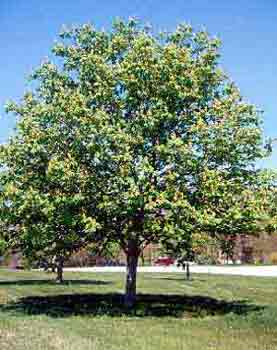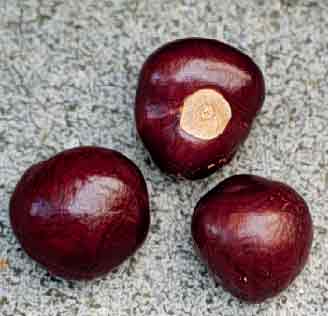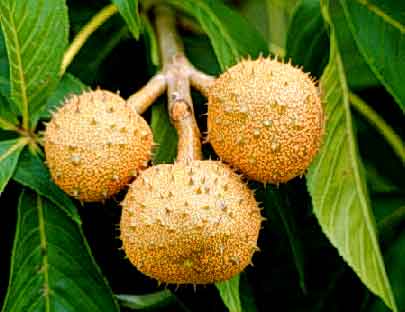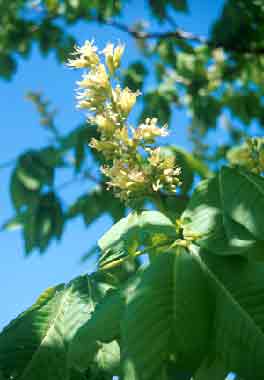 Ohio Buckeye - Aesculus glabra
Ohio Buckeye - Aesculus glabra
Buckeye Family (Hippocastanaceae)
Ohio buckeye can occur in all parts of Kentucky, but is most common in the Bluegrass region and Western Kentucky. This tree is most recognized by its leaf that is separated into five leaflets and its shiny chestnut-like seeds found inside a prickly, leathery husk. The Kentucky and National champion tree is in Casey County and is nearly 150 feet tall.
 Culture: Ohio buckeye is useful in large areas, but it is not a good tree for street use or in small residential areas. It prefers moist, deep, well-drained, slightly acidic soil, and can be grown in full sun or partial shade. It is hardy in Zones 3 to 7. Ohio buckeye develops leaf scorch and drops its leaves prematurely in hot, droughty conditions. It is bothered by several diseases and insects. Leaf blotch, in which leaves develop discolored spots that change to brown, is serious. It is also susceptible to powdery mildew, leaf spot, wood rot, anthracnose, canker, walnut scale, comstock mealybug, white-marked tussock moth, Japanese beetle, bagworm and flat-headed borer. For all these reasons, it should be planted in naturalized situations and not as a specimen plant. It should be pruned in early spring.
Culture: Ohio buckeye is useful in large areas, but it is not a good tree for street use or in small residential areas. It prefers moist, deep, well-drained, slightly acidic soil, and can be grown in full sun or partial shade. It is hardy in Zones 3 to 7. Ohio buckeye develops leaf scorch and drops its leaves prematurely in hot, droughty conditions. It is bothered by several diseases and insects. Leaf blotch, in which leaves develop discolored spots that change to brown, is serious. It is also susceptible to powdery mildew, leaf spot, wood rot, anthracnose, canker, walnut scale, comstock mealybug, white-marked tussock moth, Japanese beetle, bagworm and flat-headed borer. For all these reasons, it should be planted in naturalized situations and not as a specimen plant. It should be pruned in early spring.
- Native habitat: Pennsylvania to Nebraska, Kansas and Alabama. Growth habit: Round or oval, dense, with coarse texture. Usually low-branched with branches bending down then arching back up.
- Tree size: Averages 20 to 40 feet tall with a similar width, although it can reach a height of 80 feet.
- Flower and fruit: Perfect flowers are greenish yellow and 1 inch long. They are borne in 4- to 7-inch-long panicles in early to mid-May. Fruit is a light brown capsule with a prickly cover. Seeds are poisonous to humans, pets and livestock.
 Leaf: Opposite, palmately compound, 3 to 6 inches long, usually with five leaflets although there can be seven. Bright green when unfolding, dark green in summer. Fall color is usually yellow but can be orange-red to reddish brown. Foliage is somewhat toxic to discourage herbivory.
Leaf: Opposite, palmately compound, 3 to 6 inches long, usually with five leaflets although there can be seven. Bright green when unfolding, dark green in summer. Fall color is usually yellow but can be orange-red to reddish brown. Foliage is somewhat toxic to discourage herbivory.- Hardiness: Winter hardy to USDA Zone 3.
 Additional information:
Additional information:Buckeyes are named for their seeds, which are brown with a light eyespot that looks like the eye of a deer. Aesculin is the toxic substance in buckeye seeds. Native Americans boiled buckeyes to leach out aesculin and make them edible for humans. People used to carry buckeyes in their pockets to protect them from rheumatism. In addition, an extract of Ohio buckeye bark has been used to stimulate the cerebro-spinal system.
The wood of Ohio buckeye is light, weak and soft. It has been used for artificial limbs because it does not split easily. Buckeye logs were once hollowed out and made into troughs to catch maple sap. Buckeye logs were also hollowed out to make cradles in pioneer days, and settlers made hats from buckeye shavings.
Ohio buckeye, which was first cultivated in 1809, can be transplanted easily while still dormant in early spring or after it loses its leaves in fall.


